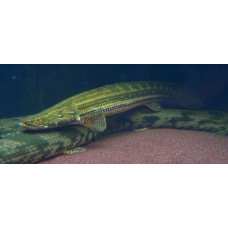Polypteridae is a family of fishes of the Polypteriformes order. The body is elongated, covered with ganoid scales. Pectoral fins of uniserial type with a fleshy blade at the base. The dorsal fin consists of a row of small fins, each with a barbed ray. There is a spatula. Swim bladder is two-chambered, cellular, can perform respiratory functions. The length of the body 70-90 cm. Dwell in fresh waters of tropical Africa. Feed on invertebrates and fish. Polypteridae are of local commercial importance. Polypterus bichir, a predator reaching 90 cm in length, inhabits the upper reaches of the Nile and the basins of Lakes Chad and Rudolph.
There are 14 known modern species distributed in tropical Africa. It is a rather ancient group, sharing some common features with keysteppers and bipedal fishes, which evolved convergently (independently). The oldest fossil finds of multifinned fish date back to the mid-Jurassic period.
Polypteridae are characterized by an elongated and laterally compressed or valcate body covered with unusually strong rhombic ganoid scales. On the back there are from 5 to 18 folding dorsal fins of unusual structure: each fin is a strong spike, on the back side of which, closer to the apex, sits one or more soft rays. Well-developed caudal fin, outwardly almost symmetrical, actually unequal-lo-past, heterocercal structure. The bases of the large pectoral fins in the form of fleshy lobes. The pelvic fins are displaced to the posterior half of the abdomen or absent (Galamoichthys). Anal fin is small, located in close proximity to the caudal fin. The shoulder and pelvic girdles and the axial skeleton are ossified. The vertebral bodies are biconcave (amphi-cele). The cartilaginous skull (chondrocranium) is covered from above with numerous dermal bones. The gill cover consists of only three elements (no intercalary bone). The rays of the gill membrane, characteristic of bony fishes, are absent; instead, there is a pair of large throat (gular) plates.
There is a paired squirt, equipped with a valve, and opercular gill. The serpentine head is strongly flattened. The mouth is large. The jaws are equipped with large teeth of ordinary structure. There is a swim bladder performing a respiratory function in the form of two long sacs lying under the digestive tract. The right sac extends the entire length of the abdomen and opens into the pharynx from below; shorter left sac is an outgrowth of the right sac and the pharynx with its own duct is not connected (swim bladder of this structure, called "ventral lung", is also characteristic of bivalve fish and has nothing to do with the swim bladder of other bony fishes, located above the digestive tract, opening into the pharynx from above and acting as a hydrostatic organ). There is a spiral valve in the intestine. The well-developed arterial cone in the heart is equipped with numerous valves: in the most primitive species of Polypterus they sit in 8 rows, and in the most specialized species - in 4 rows. Polypteridae have a very specific swim bladder. It consists of two compartments (larger right and smaller left). Both sections are connected to the intestine by a common channel and actually serve as an additional respiratory organ (in addition to the gills). In this case (in contrast to the bipedal) internal nostrils are absent.
The larvae are provided with large external gills (one on each side) sitting above the normal gills, which are attached to the hyoid arch and disappear a few weeks after hatching.
Polypteridae inhabit freshwater bodies of tropical Africa, preferring quiet river backwaters and lagoons of lakes with lush aquatic vegetation and temporary swamps formed during river flooding. During the day, the fish hide in hiding on the bottom, "standing" in a characteristic posture, leaning on the pectoral fins and tail.
Spawning of Polypteridae occurs in August-September, when the rainy season begins and swollen rivers flood vast areas of lowlands that turn into temporary swamps. Polypterids leave rivers and breed here (at least only in flooded floodplains females with mature eggs, larvae and juveniles are caught). Mating games are accompanied by a complex ritual and jumping out of the water. The male and female are then carried in a rapid dance, closely pressed against each other, then separate, and then the male circles around the motionless frozen female, occasionally touching her snout or "caressing" widely spread swollen anal fin. Nothing is known about fertilization and laying of eggs of polypterans. The nest must not be constructed at all, and small eggs are laid on aquatic vegetation. With the onset of the dry period and as the water level in temporary pools drops, adult fish and juveniles leave them and return to rivers.
Polypteridae
Tags: polypteridae



